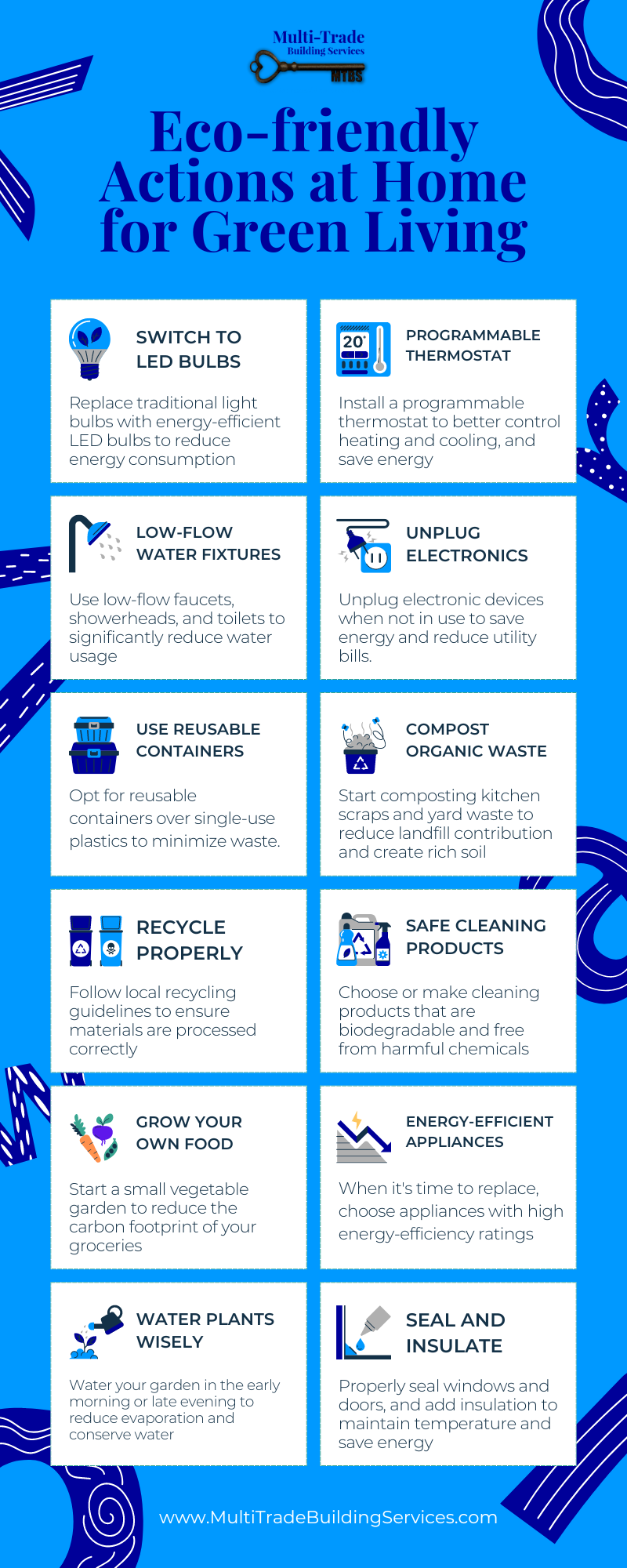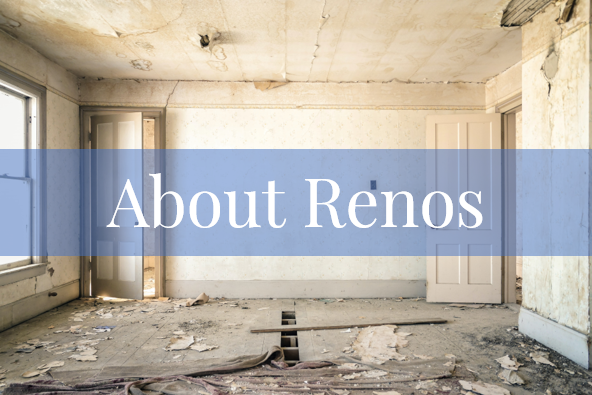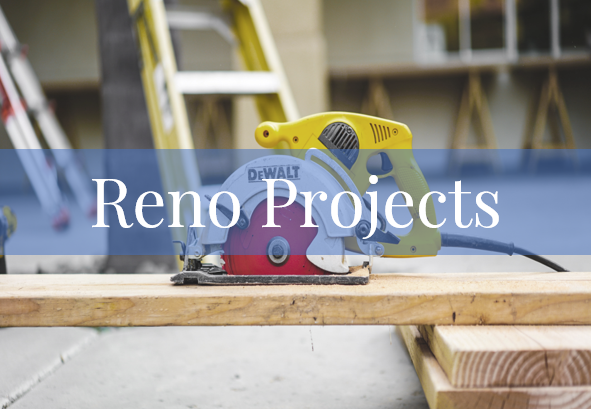Eco-Friendly Renovations: Sustainable Practices for Your Home
/Renovating your home with sustainability in mind is not only good for the environment but can also lead to long-term savings on energy costs, improved indoor air quality, and increased home value. Eco-friendly renovations focus on using sustainable materials, improving energy efficiency, and reducing the overall carbon footprint of your home. In this blog post, we’ll explore various sustainable practices you can incorporate into your home renovation project.
The Importance of Eco-Friendly Renovations
Before diving into specific sustainable practices, it’s important to understand why eco-friendly renovations matter. The construction and operation of buildings significantly impact the environment through energy consumption, resource use, and waste production. By opting for sustainable renovation practices, homeowners can:
Reduce Environmental Impact: Sustainable renovations help reduce the depletion of natural resources, minimize waste, and lower greenhouse gas emissions.
Improve Energy Efficiency: Eco-friendly renovations often involve upgrading to energy-efficient systems and appliances, which can lead to substantial savings on utility bills.
Enhance Indoor Air Quality: Using non-toxic materials and improving ventilation can lead to healthier indoor environments.
Increase Home Value: Sustainable features can make a home more attractive to environmentally conscious buyers, potentially increasing its market value.
Planning Your Eco-Friendly Renovation
Successful eco-friendly renovations start with careful planning. Here are some steps to consider:
Assess Your Home’s Current Condition: Identify areas where your home could be more energy-efficient or where sustainable improvements can be made.
Set Goals: Determine what you want to achieve with your renovation. Goals might include reducing energy consumption, using recycled materials, or improving indoor air quality.
Budget for Sustainability: Allocate part of your budget to sustainable upgrades. While some eco-friendly options might have a higher upfront cost, they often pay off in the long run through energy savings and increased home value.
Research Sustainable Materials and Methods: Look into eco-friendly materials and construction methods. Consult with contractors who specialize in sustainable building practices.
Energy Efficiency Upgrades
Improving energy efficiency is one of the most impactful ways to make your home more sustainable. Here are some energy-efficient upgrades to consider:
Insulation: Proper insulation is crucial for maintaining a consistent indoor temperature and reducing energy consumption. Consider using eco-friendly insulation materials like cellulose, cotton, or sheep’s wool.
Windows and Doors: Replace old, drafty windows and doors with energy-efficient models. Look for products with a high Energy Star rating and low U-values, which indicate better insulating properties.
Heating and Cooling Systems: Upgrade to energy-efficient heating and cooling systems, such as heat pumps or high-efficiency furnaces. Consider installing a programmable thermostat to optimize energy use.
Solar Panels: Installing solar panels can significantly reduce your reliance on grid electricity and lower your energy bills. Although the initial investment is substantial, government incentives and long-term savings make it a worthwhile consideration.
Lighting: Replace incandescent bulbs with energy-efficient LED bulbs. These use less energy and have a longer lifespan.
Appliances: Choose Energy Star-rated appliances, which are designed to consume less energy and water. This includes refrigerators, dishwashers, washing machines, and dryers.
Sustainable Materials
Choosing sustainable materials for your renovation is another critical aspect of eco-friendly building. Here are some options:
Recycled and Reclaimed Materials: Using recycled or reclaimed materials reduces waste and the need for new resources. Examples include reclaimed wood for flooring or furniture, recycled metal for fixtures, and recycled glass for countertops or backsplashes.
Sustainable Wood: If using new wood, opt for products certified by the Forest Stewardship Council (FSC), which ensures the wood comes from responsibly managed forests.
Bamboo: Bamboo is a rapidly renewable resource that can be used for flooring, cabinetry, and furniture. It grows quickly and requires fewer pesticides and fertilizers than traditional wood.
Recycled Glass and Concrete: These materials can be used for countertops, tiles, and other surfaces. They are durable and have a lower environmental impact compared to their traditional counterparts.
Low-VOC Paints and Finishes: Volatile organic compounds (VOCs) in paints and finishes can negatively impact indoor air quality. Choose low-VOC or VOC-free products to maintain a healthier home environment.
Water Conservation
Water conservation is another key component of sustainable renovations. Implementing water-saving measures can reduce your water bills and conserve a vital natural resource.
Low-Flow Fixtures: Install low-flow faucets, showerheads, and toilets to reduce water usage without sacrificing performance.
Rainwater Harvesting: Consider installing a rainwater harvesting system to collect and store rainwater for irrigation and other non-potable uses.
Greywater Systems: Greywater systems recycle water from sinks, showers, and laundry for use in landscaping and toilet flushing.
Efficient Landscaping: Opt for drought-resistant plants and efficient irrigation systems to reduce water consumption in your garden.
Indoor Air Quality
Improving indoor air quality is essential for creating a healthy living environment. Here are some strategies:
Ventilation: Ensure your home is well-ventilated to reduce indoor air pollutants. Install energy recovery ventilators (ERVs) or heat recovery ventilators (HRVs) to improve air exchange while conserving energy.
Air Purifiers: Use air purifiers to remove allergens, dust, and other pollutants from the air.
Non-Toxic Materials: Choose materials that emit low levels of harmful chemicals. This includes low-VOC paints, adhesives, and finishes, as well as natural flooring options like cork or linoleum.
Houseplants: Incorporate houseplants that are known for their air-purifying qualities. Plants like spider plants, peace lilies, and snake plants can help remove toxins from the air.
Waste Reduction and Recycling
Minimizing waste and recycling materials during a renovation can significantly reduce the environmental impact.
Deconstruction vs. Demolition: Instead of demolishing existing structures, opt for deconstruction, which involves carefully dismantling buildings to salvage materials for reuse.
Recycling Programs: Participate in local recycling programs for construction and demolition waste. Many materials, including metal, wood, and concrete, can be recycled.
Donating Unused Materials: Donate leftover materials to organizations like Habitat for Humanity, which can use them in other building projects.
Composting: Set up a composting system for organic waste generated during the renovation, such as wood shavings and plant debris.
Renewable Energy Sources
Incorporating renewable energy sources into your renovation can further reduce your home’s carbon footprint.
Solar Energy: In addition to solar panels, consider solar water heaters, which use the sun’s energy to heat water for your home.
Wind Energy: If you live in an area with sufficient wind, installing a small wind turbine can generate electricity for your home.
Geothermal Energy: Geothermal systems use the earth’s stable temperature to heat and cool your home efficiently.
Biomass: Biomass systems use organic materials like wood pellets or agricultural waste to produce energy. These can be used for heating and electricity generation.
Green Building Certifications
Pursuing green building certifications can ensure your renovation meets high sustainability standards.
LEED Certification: The Leadership in Energy and Environmental Design (LEED) certification is a globally recognized symbol of sustainability achievement. It provides a framework for healthy, efficient, and cost-saving green buildings.
ENERGY STAR Certification: ENERGY STAR certification ensures that your home meets strict energy efficiency guidelines set by the government.
Living Building Challenge: This certification focuses on creating regenerative buildings that operate in harmony with the environment. It emphasizes sustainability across all aspects of building design and operation.
Passive House Certification: Passive House standards focus on creating buildings with high energy efficiency, using passive heating and cooling techniques to reduce energy consumption significantly.
Educating and Engaging Homeowners
Educating yourself and other homeowners about sustainable practices can amplify the impact of your eco-friendly renovation.
Workshops and Seminars: Attend workshops and seminars on sustainable building practices. These events can provide valuable insights and connect you with like-minded individuals.
Online Resources: Utilize online resources such as blogs, forums, and webinars to stay informed about the latest trends and technologies in sustainable building.
Community Involvement: Get involved in local sustainability initiatives and share your experiences with your community. Encouraging others to adopt eco-friendly practices can create a larger positive impact.
Hiring Sustainable Contractors: Choose contractors who specialize in sustainable building practices. Their expertise can guide you in making environmentally responsible choices throughout your renovation.
In summary…
Eco-friendly renovations are not only beneficial for the environment but also for your wallet and well-being. By incorporating sustainable practices such as energy efficiency upgrades, using sustainable materials, conserving water, improving indoor air quality, reducing waste, and utilizing renewable energy sources, you can create a healthier, more efficient, and valuable home. Careful planning, ongoing education, and community engagement are key to maximizing the benefits of your sustainable renovation. Embrace the opportunity to make a positive impact on the environment while enhancing your living space.
Learn More About Eco-Friendly Renovations
Interested in exploring sustainable renovation options further? Here are some helpful resources to guide you:
Sustainable Home Renovation Guide – Explore practical steps for eco-friendly home improvements, including energy-efficient upgrades and sustainable material choices. Canada Green Building Council’s Green Building Programs
Green Renovation Tips – Learn about eco-friendly renovation practices with tips on energy savings and sustainable materials. Green Building Advisor
Water Conservation Tips for Homeowners – Discover ways to conserve water in your home, from efficient fixtures to landscaping ideas. Canadian Water Efficiency Network
Guide to Energy Efficiency in Homes – Find detailed information on energy-saving methods, including appliances, insulation, and heating solutions. Natural Resources Canada – Energy Efficiency
















